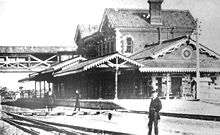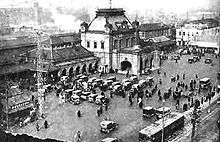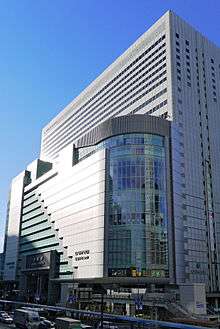Ōsaka Station
Osaka Station 大阪駅 | |
|---|---|
|
Osaka Station City | |
| Location |
1-1 Umeda Sanchōme, Kita-ku, Osaka, Osaka Prefecture (大阪市北区梅田三丁目1-1) Japan |
| Operated by | JR West |
| Line(s) |
|
| Connections |
|
| History | |
| Opened | 1874 |
Osaka Station (大阪駅 Ōsaka-eki) is a major railway station in the Umeda district of Kita-ku, Osaka, Japan, operated by West Japan Railway Company (JR West). It forms the city's main rail terminal in the north.
Although it is officially served by only the JR Kobe/Kyoto Lines (Tōkaidō Main Line) and the Osaka Loop Line, Osaka is the starting point of JR Takarazuka Line service, and serves as the terminal for trains bound for the San'in region via JR Takarazuka Line and the Hokuriku region via JR Kyoto Line, while offering connections to trains bound for Nara, Wakayama and Kansai International Airport via the Osaka Loop Line.
Umeda Station (Hankyu, Hanshin, and Osaka Municipal Subway Midosuji Line), Nishi-Umeda Station (Subway Yotsubashi Line) and Higashi-Umeda Station (Subway Tanimachi Line) are directly connected to Osaka Station, and Kitashinchi Station on the JR Tōzai Line is within walking distance.
Osaka Station and Umeda Station, effectively part of the same complex, together constitute the busiest station in Western Japan, serving 2,343,727 passengers daily in 2005, and the fourth-busiest railway station in the world.[1]
Osaka Station also houses a large terminal for overnight bus services to other cities in Japan, and until March 2013 also had a nearby freight terminal complex, Umeda Freight Terminal, owned by JR Freight.
Station layout

Osaka station is elevated above street level, on the second floor of the station complex. There are four concourses, corresponding to four sets of ticket gates: the Midosuji gates, serving as a transfer point to Hankyu and Subway Umeda Station and Higashi-Umeda Station; the Central gates, with access to Daimaru, Lucua, Yodobashi Camera, Umeda Sky Building, Grand Front and transfers to Hanshin Umeda and JR Kitashinchi Station; the Sakurabashi gates, with access to Osaka Garden City and transfers to Subway Nishi-Umeda Station, city bus, hotel shuttle buses and taxi; and the Bridge Gates, with direct access into Daimaru and Lucua, as well as a bridge passage to Hankyu Umeda. The Midosuji concourse is on the lower level, with escalators and elevators leading directly to platforms; the Central concourse has both direct escalators and a mezzanine-level transfer passage connected by stairs; the Sakurabashi concourse has gates on ground level but is primarily on the mezzanine level, connected to the central concourse by a corridor; and the Bridge Gate is on the third level above the platforms, and connected by escalators and elevators.
Platforms and tracks are on the second floor. There were previously six island platforms and one side platform serving 13 tracks; the highest-numbered track was Track 11, as the Osaka Loop Line tracks were referred to as "Inner Loop" and "Outer Loop" only. In preparation for the construction of the new north building, the sixth platform was closed and the seventh was removed altogether; at the same time, the remaining platforms were renumbered so that Tracks 1 and 2 were for the Osaka Loop Line, and so on. The sixth platform reopened on 20 December 2009 and there became five island platforms and a side platform serving 11 tracks in total (up to the new Track 11—the old Track 9). The remainder of the old Track 11 platform, on the west side of the station, is now used as a pedestrian walkway linking the North Gate Building with its parking garage. There was originally a through track in between tracks 8 and 9, but it had been long disused; during the closure of Track 11, the platform for Tracks 9 and 10 was expanded and this track was used temporarily as Track 9. Since 12 October 2010, this track has been used permanently as Track 8 after the widening of the adjoining platform.
Platforms
| 1 | ■ Osaka Loop Line | inner track (counter-clockwise) for Nishikujō, Bentenchō, Shin-Imamiya and Tennōji |
| ■ JR Yumesaki Line | for Universal City and Sakurajima | |
| ■ Yamatoji Line | for Tennōji, Ōji and Nara | |
| ■ Hanwa Line | for Tennōji and Wakayama | |
| ■ Kansai Airport Line | for Tennōji and Kansai Airport | |
| 2 | ■ Osaka Loop Line | outer track (clockwise) for Kyōbashi, Tsuruhashi and Tennoji |
| 3 | ■ JR Takarazuka Line Fukuchiyama Line |
for Takarazuka, Shin-Sanda, Sasayamaguchi and Fukuchiyama |
| ■ limited express "Kounotori" | for Fukuchiyama, Toyooka and Kinosaki Onsen | |
| ■ limited express "Super Hakuto" | for Tottori and Kurayoshi | |
| ■ JR Kobe Line | rapid services (weekday mornings) and special rapid services (weekday rush hours) for Sannomiya, Nishi-Akashi and Himeji | |
| 4 | ■ JR Takarazuka Line Fukuchiyama Line |
for Takarazuka, Shin-Sanda, Sasayamaguchi and Fukuchiyama |
| ■ limited express "Kounotori" | for Fukuchiyama, Toyooka and Kinosaki Onsen | |
| ■ JR Kobe Line | special rapid services for Sannomiya, Akashi and Himeji (weekday rush hours) | |
| ■ limited express "Hamakaze" | for Toyooka, Kinosaki Onsen, Hamasaka and Tottori | |
| 5 | ■ JR Kobe Line | rapid services and special rapid services for Sannomiya, Nishi-Akashi and Himeji |
| 6 | ■ JR Kobe Line | local trains for Tachibana and Kōshienguchi |
| ■ JR Takarazuka Line | from the JR Kyoto Line (local trains) for Tsukaguchi and Inadera | |
| 7 | ■ JR Kyoto Line | local trains for Shin-Ōsaka and Suita |
| 8 | ■ JR Kyoto Line | rapid services and special rapid services for Shin-Ōsaka, Takatsuki, Kyoto and Maibara |
| 9, 10 | ■ JR Kyoto Line | rapid services (weekday mornings) and special rapid services (weekday rush hours) for Shin-Ōsaka, Takatsuki, Kyoto and Maibara |
| 10 | ■ limited express "Biwako Express" | for Maibara |
| 11 | ■ limited express "Thunderbird" | for Fukui, Kanazawa and Wakura-Onsen |
| ■ limited express "Hida" | for Gifu and Takayama | |
| ■ limited express "Sunrise Izumo" "Sunrise Seto" |
for Tokyo |
Limited express trains
- for the Hokuriku Line
- Limited express Thunderbird (Osaka - Kanazawa, Wakura-Onsen)
- for the Tokaido Line and the Takayama Line
- Limited express Sunrise Izumo/Sunrise Seto (Takamatsu/Izumoshi → Tokyo) - Tokyo-bound train only
- Limited express Hida (Osaka - Takayama)
- Limited express Biwako Express (Osaka - Kusatsu, Maibara)
- for the San'in region
- Limited express Super Hakuto (Kyoto - Tottori, Kurayoshi) via the Chizu Express Chizu Line
- Limited express Hamakaze (Osaka - Kasumi, Hamasaka, Tottori) via the Bantan Line
- for the north area of the Kansai region via the Fukuchiyama Line
- Limited express Kounotori (Shin-Osaka - Fukuchiyama, Toyooka, Kinosaki-Onsen)
Adjacent stations
| « | Service | » | ||
|---|---|---|---|---|
| Tokaido Line (JR Kyoto Line, JR Kobe Line) | ||||
| Shin-Ōsaka | Special Rapid | Amagasaki | ||
| Shin-Ōsaka | Rapid | Amagasaki | ||
| Shin-Ōsaka | Local (Including through to and from the JR Takarazuka Line) |
Tsukamoto | ||
| Through to and from the Fukuchiyama Line (JR Takarazuka Line) | ||||
| Terminus | Tambaji Rapid Rapid |
Amagasaki | ||
| Terminus | Local trains returning at Osaka | Amagasaki | ||
| Osaka Loop Line | ||||
| Temma | All services | Fukushima | ||
History


Osaka Station opened on May 11, 1874 as one of the first railway stations in the Kansai region when the railway between Osaka and Kobe started operation. It was electrified along with the Tōkaidō Main Line in 1934.
The existence of the station naturally made the area the primary transport hub of the city. Railways that set Ōsaka Station as the terminal or built their terminal around Osaka Station include Osaka Railway (present-day east half of the Osaka Loop Line) in 1895, Nishinari Railway (west half of the Osaka Loop Line) in 1898, Hanshin Electric Railway in 1906, Minoo Arima Electric Tramway (Hankyu Railway) in 1910, and Osaka Municipal Subway in 1933. The regional railways tended to name their stations Umeda, the name of area, rather than the city name.
The air raids in World War II flattened the blocks in front of the station. Immediately after the war the area turned into a huge black market, the atmosphere of which remained until the redevelopment in the 1970s.
The station building was rebuilt in 1901, 1940 and 1979 (north building). In 1983, a high-rise building, Acty Osaka, which housed a department store and a hotel, was added to the south of the station. A new north station building (the North Gate Building) was opened in 2011, coinciding with an expansion of Acty Osaka (now the South Gate Building) and major renovation of the station areas with a new concourse and north-south connection. This is the first step in a larger drive to redevelop the land used by JR Freight's Umeda Terminal, which is seen as the last undeveloped piece of real estate in the area. Plans also call for moving the Umeda Freight Line underground and establishing a terminal for the Osaka Higashi Line just north of ALBi, with an eye towards a future extension to JR Namba Station (thus alleviating delays on the Osaka Loop Line caused by Limited Express trains), though details have not yet been firmly decided.
Major renovation
 August 2007
August 2007 June 2009
June 2009 September 2009
September 2009 March 2010
March 2010 April 2011
April 2011
Surrounding area

- Osaka Station City
- South Gate Building
- Daimaru Umeda
- Pokémon Center Osaka
- Tokyu Hands
- Hotel Granvia Osaka
- North Gate Building
- Lucua (shopping mall)
- Lucua 1100 (shopping mall, successor of Osaka Mitsukoshi-Isetan Depertment Store)
- Osaka Station City Cinema
- Itochu
- JR Expressway bus terminal
- eki marche (restaurants and fashion stores)
- ALBi (outdoor shops and fashion stores)
- Umesan-koji (restaurants)
- South Gate Building
North side
- Hankyu bus stop (for Kashima-ekimae and Nishikawa via Oyodo-minami Itchome and Juso)
- Hankyu San-bangai
- San-bangai Expressway bus terminal
- Hotel New Hankyu Osaka
- Airport shuttle bus terminal for Kansai International Airport and Osaka International Airport
- Grand Front Osaka
- Yodobashi Camera
- Shin Umeda City
- Chayamachi district
- NU Chayamachi
- Mainichi Broadcasting System
- Umeda Arts Theater
- Loft
South side
- Osaka city bus terminal (Osaka-ekimae)
- Hankyu Department Store, Hanshin Department Store (Both owned by Hankyu Hanshin Department Stores, Inc.)
- Hankyu bus stop (for Hinodecho (Hankyu Bus Co.), Kozushima, Hankyu Sonoda and Toyonaka via Juso)
- Umeda DT Tower
- Osaka Ekimae Buildings
- Osaka Central Post Office (in Osaka Ekimae Dai-Ichi Building)
- Osaka Marubiru Building
- Airport shuttle bus terminal for Osaka International Airport
- Hilton Osaka (Plaza East)
- Osaka Garden City
- Hilton Osaka (Plaza West)
- Ritz-Carlton Osaka
- Herbis Osaka
- Airport shuttle bus for Kansai International Airport and Osaka International Airtport
- Herbis Ent
- Osaka Shiki Theatre
- Billboard live Osaka
- Mainichi Shimbun
- HEP Five
See also
References
External links
| Wikimedia Commons has media related to Osaka Station. |
Coordinates: 34°42′6.87″N 135°29′41.92″E / 34.7019083°N 135.4949778°E